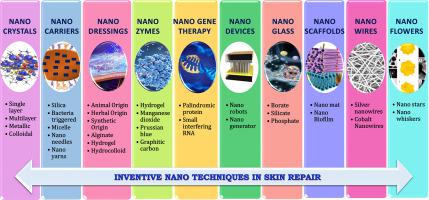Journal of Controlled Release ( IF 10.5 ) Pub Date : 2022-07-17 , DOI: 10.1016/j.jconrel.2022.07.005 R I Jari Litany 1 , P K Praseetha 1

|
Overall, chronic injuries place considerable burden on patients and health systems. The skin injuries are exposed to inflammatory bacteria and hinder the healing process. The skin being the biggest tissue of the whole body ensures protection against microbial invasion, dehydration, and against chemical, thermal, bright radiations and mechanical agents. When injured, the skin loses its defensive purpose and the attack of bacterial types arises with the loss of protein, water, and electrolytes. Improved wound closure therapy helps to restore normal skin function by managing wounds with the help of a suitable skin replacement. According to the type of wound and its healing ability, an appropriate skin replacement system must be identified. Nanofibrous layers because of their permeable structure, their large superficial reach and their similarity with the local extracellular network serve as cutaneous substitution for dealing with deep and superficial injuries. By a diminished microbial load without infestation, scab formation and infiltration of defense cells in the initial phase, acute injuries are usually characterized. Here recovery is related with epithelialization, angiogenesis and relocation of fibroblasts. The wound becomes obstinate when microbial biofilms are developed while the immune system does not manage to eliminate the infection. Increased inflammatory process, lower deep tissue oxygenation, fibrin cuffs, fibroblastic senescence, altered angiogenesis, stalled re-epithelialization and chronic infection have been visualized. Conventional wound mending treatments for the most part falling flat to supply a great clinical result, either basically like wound epithelialization and regulation of fluid loss or practically like histological highlights that decide versatility, strength, affectability, etc. Conventional wound therapies commonly fail to offer a better medical output, like wound epithelialization and regulation of fluid reduction or physiologically like cellular features that determine durability, sensitivity, elasticity, etc. Nanotechnology may be a dependable investigation space for wound-healing treatments through their versatile physicochemical properties. Advancing nano platforms with novel solutions for curing chronicdiabetic wounds are discussed in detail that can guide further research in this sector.
中文翻译:

伤口修复大联盟的小人物:当今纳米技术的组织再生工具
总体而言,慢性损伤给患者和卫生系统带来了相当大的负担。皮肤损伤暴露于炎性细菌并阻碍愈合过程。皮肤是全身最大的组织,可确保防止微生物入侵、脱水以及化学、热、明亮辐射和机械剂。受伤时,皮肤会失去防御功能,细菌类型的攻击会随着蛋白质、水和电解质的流失而出现。改进的伤口闭合疗法通过在合适的皮肤替代物的帮助下管理伤口来帮助恢复正常的皮肤功能。根据伤口的类型及其愈合能力,必须确定合适的皮肤替代系统。纳米纤维层由于其可渗透结构,它们的大表浅范围和与局部细胞外网络的相似性可作为皮肤替代物来处理深部和浅表损伤。在初始阶段,通过减少微生物负荷而没有侵染、结痂形成和防御细胞浸润,通常以急性损伤为特征。这里的恢复与成纤维细胞的上皮化、血管生成和重新定位有关。当微生物生物膜形成而免疫系统无法消除感染时,伤口变得顽固。已经观察到炎症过程增加、深部组织氧合降低、纤维蛋白袖带、成纤维细胞衰老、血管生成改变、上皮再形成停滞和慢性感染。传统的伤口疗法通常无法提供更好的医疗输出,如伤口上皮化和液体减少的调节或决定耐久性、敏感性、弹性等的生理细胞特征。纳米技术可能是伤口愈合治疗的可靠研究空间。它们具有多种物理化学性质。详细讨论了推进纳米平台与治疗慢性糖尿病伤口的新解决方案,以指导该领域的进一步研究。











































 京公网安备 11010802027423号
京公网安备 11010802027423号